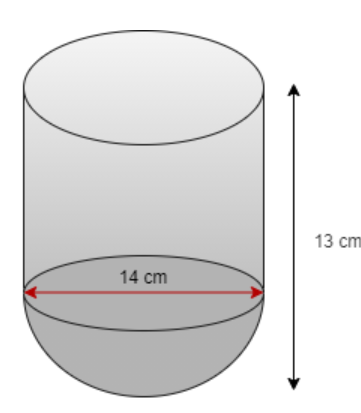
The vessel is in the form of a hollow hemisphere mounted by a hollow cylinder. The diameter of the hemisphere is 14 cm and the total height of the vessel is 13 cm. Find the inner surface area of the vessel.
Answer
471.6k+ views
Hint: In this question remember that diameter of the cylinder is equal to the diameter of the hemisphere and also remember that height of the hemisphere is the radius of the hemisphere. The surface area of the hemisphere and cylinder is added to find the surface area of the vessel.
Complete step-by-step solution

According to the question,
A hollow hemisphere is mounted with a cylinder and radius of hemisphere = \[\dfrac{{14}}{2} = 7cm\]
And the total height of the system is 13cm, then we have to find the inner surface area of the system.
Now, we know that the total inner surface area = inner surface area of the hemisphere + Inner surface area of the cylinder.
Since, height of the cylinder = (height of the system – radius of hemisphere) = 13cm – 7cm = 6cm.
Therefore, total inner surface area = $2\pi {r^2} + 2\pi rh$
\[ \Rightarrow \]Total inner surface area $ = \left( {2 \times \dfrac{{22}}{7} \times {7^2} + 2 \times \dfrac{{22}}{7} \times 7 \times 6} \right)c{m^2}$
\[ \Rightarrow \]Total inner surface area$ = \left( {308 + 264} \right)c{m^2} = 572c{m^2}$
Therefore, the inner surface area of the vessel is equal to $572c{m^2}$
Note: To solve this type of questions, it is important to know the formulas of mensuration, like in this question we used the formulas:
Curved surface area of a hemisphere = $2\pi {r^2}$
Curved surface area of a cylinder = $2\pi rh$, where r is the radius, and h is the height of the cylinder.
Complete step-by-step solution

According to the question,
A hollow hemisphere is mounted with a cylinder and radius of hemisphere = \[\dfrac{{14}}{2} = 7cm\]
And the total height of the system is 13cm, then we have to find the inner surface area of the system.
Now, we know that the total inner surface area = inner surface area of the hemisphere + Inner surface area of the cylinder.
Since, height of the cylinder = (height of the system – radius of hemisphere) = 13cm – 7cm = 6cm.
Therefore, total inner surface area = $2\pi {r^2} + 2\pi rh$
\[ \Rightarrow \]Total inner surface area $ = \left( {2 \times \dfrac{{22}}{7} \times {7^2} + 2 \times \dfrac{{22}}{7} \times 7 \times 6} \right)c{m^2}$
\[ \Rightarrow \]Total inner surface area$ = \left( {308 + 264} \right)c{m^2} = 572c{m^2}$
Therefore, the inner surface area of the vessel is equal to $572c{m^2}$
Note: To solve this type of questions, it is important to know the formulas of mensuration, like in this question we used the formulas:
Curved surface area of a hemisphere = $2\pi {r^2}$
Curved surface area of a cylinder = $2\pi rh$, where r is the radius, and h is the height of the cylinder.
Recently Updated Pages
Master Class 9 General Knowledge: Engaging Questions & Answers for Success

Master Class 9 English: Engaging Questions & Answers for Success

Master Class 9 Science: Engaging Questions & Answers for Success

Master Class 9 Social Science: Engaging Questions & Answers for Success

Master Class 9 Maths: Engaging Questions & Answers for Success

Class 9 Question and Answer - Your Ultimate Solutions Guide

Trending doubts
Fill the blanks with the suitable prepositions 1 The class 9 english CBSE

How do you graph the function fx 4x class 9 maths CBSE

Name the states which share their boundary with Indias class 9 social science CBSE

Difference Between Plant Cell and Animal Cell

What is pollution? How many types of pollution? Define it

What is the color of ferrous sulphate crystals? How does this color change after heating? Name the products formed on strongly heating ferrous sulphate crystals. What type of chemical reaction occurs in this type of change.




